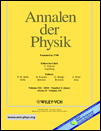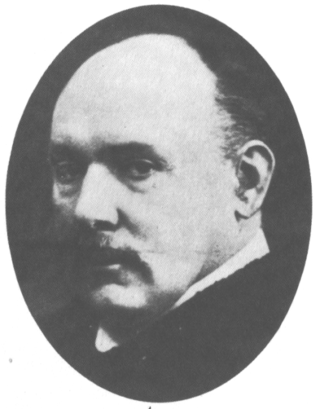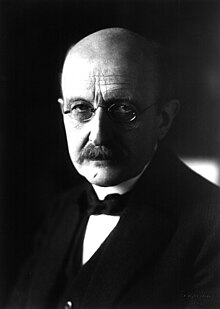
Max Karl Ernst Ludwig Planck was a German theoretical physicist whose discovery of energy quanta won him the Nobel Prize in Physics in 1918.
A photon is an elementary particle that is a quantum of the electromagnetic field, including electromagnetic radiation such as light and radio waves, and the force carrier for the electromagnetic force. Photons are massless particles that always move at the speed of light when in vacuum. The photon belongs to the class of boson particles.

The photoelectric effect is the emission of electrons from a material caused by electromagnetic radiation (light). Electrons emitted in this manner are called photoelectrons. The phenomenon is studied in condensed matter physics, solid state, and quantum chemistry to draw inferences about the properties of atoms, molecules and solids. The effect has found use in electronic devices specialized for light detection and precisely timed electron emission.
Wave–particle duality is the concept in quantum mechanics that quantum entities exhibit particle or wave properties according to the experimental circumstances. It expresses the inability of the classical concepts such as particle or wave to fully describe the behavior of quantum objects. During the 19th and early 20th centuries, light was found to behave as a wave, and then later discovered to have a particulate character, whereas electrons were found to act as particles, and then later discovered to have wavelike aspects. The concept of duality arose to name these contradictions.

Wilhelm Carl Werner Otto Fritz Franz Wien was a German physicist who, in 1893, used theories about heat and electromagnetism to deduce Wien's displacement law, which calculates the emission of a blackbody at any temperature from the emission at any one reference temperature.

In physics, Planck's law describes the spectral density of electromagnetic radiation emitted by a black body in thermal equilibrium at a given temperature T, when there is no net flow of matter or energy between the body and its environment.

The ultraviolet catastrophe, also called the Rayleigh–Jeans catastrophe, was the prediction of late 19th century to early 20th century classical physics that an ideal black body at thermal equilibrium would emit an unbounded quantity of energy as wavelength decreased into the ultraviolet range. The term "ultraviolet catastrophe" was first used in 1911 by Paul Ehrenfest, but the concept originated with the 1900 statistical derivation of the Rayleigh–Jeans law.

The emission spectrum of a chemical element or chemical compound is the spectrum of frequencies of electromagnetic radiation emitted due to electrons making a transition from a high energy state to a lower energy state. The photon energy of the emitted photons is equal to the energy difference between the two states. There are many possible electron transitions for each atom, and each transition has a specific energy difference. This collection of different transitions, leading to different radiated wavelengths, make up an emission spectrum. Each element's emission spectrum is unique. Therefore, spectroscopy can be used to identify elements in matter of unknown composition. Similarly, the emission spectra of molecules can be used in chemical analysis of substances.

Annalen der Physik is one of the oldest scientific journals on physics; it has been published since 1799. The journal publishes original, peer-reviewed papers on experimental, theoretical, applied, and mathematical physics and related areas. The editor-in-chief is Stefan Hildebrandt. Prior to 2008, its ISO 4 abbreviation was Ann. Phys. (Leipzig), after 2008 it became Ann. Phys. (Berl.).
The old quantum theory is a collection of results from the years 1900–1925 which predate modern quantum mechanics. The theory was never complete or self-consistent, but was instead a set of heuristic corrections to classical mechanics. The theory has come to be understood as the semi-classical approximation to modern quantum mechanics. The main and final accomplishments of the old quantum theory were the determination of the modern form of the periodic table by Edmund Stoner and the Pauli exclusion principle which were both premised on the Arnold Sommerfeld enhancements to the Bohr model of the atom.
The history of special relativity consists of many theoretical results and empirical findings obtained by Albert A. Michelson, Hendrik Lorentz, Henri Poincaré and others. It culminated in the theory of special relativity proposed by Albert Einstein and subsequent work of Max Planck, Hermann Minkowski and others.

The annus mirabilis papers are the four papers that Albert Einstein published in Annalen der Physik, a scientific journal, in 1905. These four papers were major contributions to the foundation of modern physics. They revolutionized science's understanding of the fundamental concepts of space, time, mass, and energy. Because Einstein published these remarkable papers in a single year, 1905 is called his annus mirabilis.
- The first paper explained the photoelectric effect, which established the energy of the light quanta , and was the only specific discovery mentioned in the citation awarding Einstein the 1921 Nobel Prize in Physics.
- The second paper explained Brownian motion, which established the Einstein relation and led reluctant physicists to accept the existence of atoms.
- The third paper introduced Einstein's theory of special relativity, which used the universal constant speed of light to derive the Lorentz transformations.
- The fourth, a consequence of the theory of special relativity, developed the principle of mass–energy equivalence, expressed in the famous equation and which led to the discovery and use of atomic energy decades later.
Quantum mechanics is the study of matter and its interactions with energy on the scale of atomic and subatomic particles. By contrast, classical physics explains matter and energy only on a scale familiar to human experience, including the behavior of astronomical bodies such as the moon. Classical physics is still used in much of modern science and technology. However, towards the end of the 19th century, scientists discovered phenomena in both the large (macro) and the small (micro) worlds that classical physics could not explain. The desire to resolve inconsistencies between observed phenomena and classical theory led to a revolution in physics, a shift in the original scientific paradigm: the development of quantum mechanics.
First quantization is a procedure for converting equations of classical particle equations into quantum wave equations. The companion concept of second quantization converts classical field equations in to quantum field equations.
The history of quantum mechanics is a fundamental part of the history of modern physics. The major chapters of this history begin with the emergence of quantum ideas to explain individual phenomena—blackbody radiation, the photoelectric effect, solar emission spectra—an era called the Old or Older quantum theories. Building on the technology developed in classical mechanics, the invention of wave mechanics by Erwin Schrödinger and expansion by many others triggers the "modern" era beginning around 1925. Paul Dirac's relativistic quantum theory work lead him to explore quantum theories of radiation, culminating in quantum electrodynamics, the first quantum field theory. The history of quantum mechanics continues in the history of quantum field theory. The history of quantum chemistry, theoretical basis of chemical structure, reactivity, and bonding, interlaces with the events discussed in this article.
In the history of quantum mechanics, the Bohr–Kramers–Slater (BKS) theory was perhaps the final attempt at understanding the interaction of matter and electromagnetic radiation on the basis of the so-called old quantum theory, in which quantum phenomena are treated by imposing quantum restrictions on classically describable behaviour. It was advanced in 1924, and sticks to a classical wave description of the electromagnetic field. It was perhaps more a research program than a full physical theory, the ideas that are developed not being worked out in a quantitative way. The purpose of BKS theory was to disprove Einstein's hypothesis of the light quantum.

Alfred Heinrich Bucherer was a German physicist, who is known for his experiments on relativistic mass. He also was the first who used the phrase "theory of relativity" for Einstein's theory of special relativity.
The Planck constant, or Planck's constant, denoted by , is a fundamental physical constant of foundational importance in quantum mechanics: a photon's energy is equal to its frequency multiplied by the Planck constant, and the wavelength of a matter wave equals the Planck constant divided by the associated particle momentum.
In 1923, American physicist William Duane presented a discrete momentum-exchange model of the reflection of X-ray photons by a crystal lattice. Duane showed that such a model gives the same scattering angles as the ones calculated via a wave diffraction model, see Bragg's Law.
A hallmark of Albert Einstein's career was his use of visualized thought experiments as a fundamental tool for understanding physical issues and for elucidating his concepts to others. Einstein's thought experiments took diverse forms. In his youth, he mentally chased beams of light. For special relativity, he employed moving trains and flashes of lightning to explain his most penetrating insights. For general relativity, he considered a person falling off a roof, accelerating elevators, blind beetles crawling on curved surfaces and the like. In his debates with Niels Bohr on the nature of reality, he proposed imaginary devices intended to show, at least in concept, how the Heisenberg uncertainty principle might be evaded. In a profound contribution to the literature on quantum mechanics, Einstein considered two particles briefly interacting and then flying apart so that their states are correlated, anticipating the phenomenon known as quantum entanglement.








